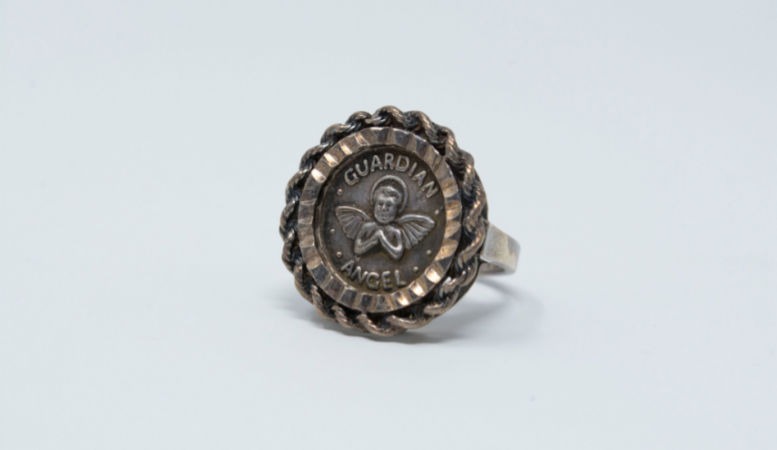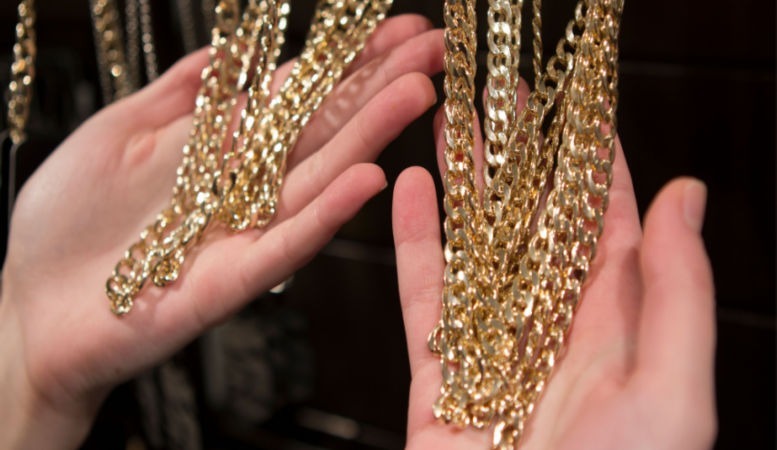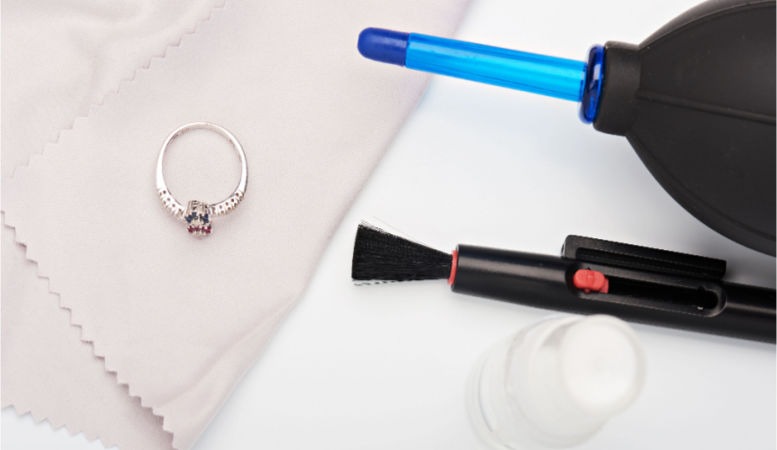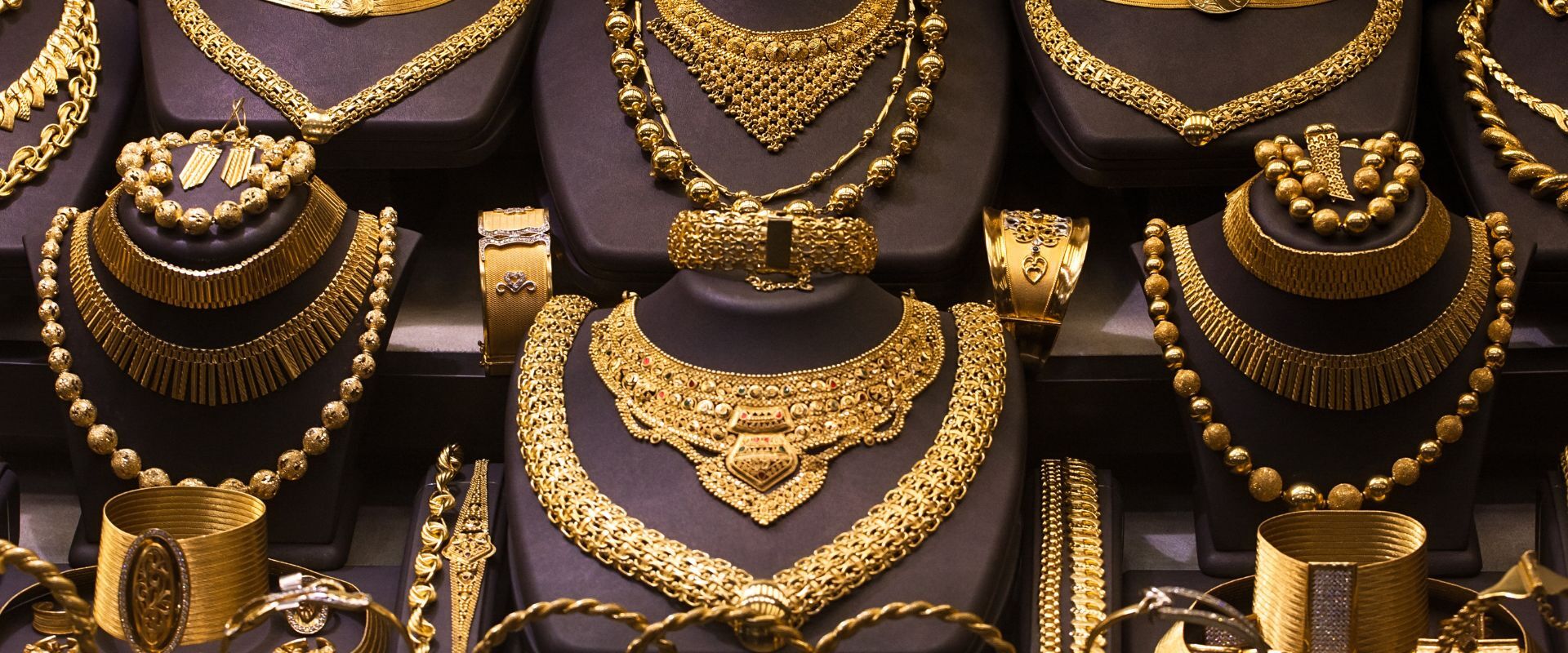Table of Contents
Most precious metals investors tend to focus on pure metals, such as silver, gold, palladium, and platinum. However, gold alloys have become increasingly popular as decorative items, increasing the value of these metals both as jewelry and as investments.
Pure gold is an extremely malleable and soft metal with a gentle yellowish tint. Pure gold doesn’t tarnish but isn’t hard enough to function as a tool or weapon. Its primary usage for many centuries has been for decorations and jewelry. In its pure form, gold is remarkably dense, making it very heavy for its size, especially compared to silver.
Popular alloys include yellow gold, which most people think of as pure but is really a mix of gold, silver, and copper, while rose gold has the same elements but a higher percentage of copper. Others include pink gold and white gold.
What is white gold? Keep reading!
What Is White Gold Made Of?

White gold is an alloy of gold, the base metal, with naturally white metal. White gold usually contains about 75% pure gold (in which case it is stamped “18 karat”) with the remaining a blend of nickel, zinc, silver, or palladium. The higher the concentration of these metals, the lighter the color of the white gold and the more durable the final result.
Gold Purity
White gold alloys can vary dramatically in quality and purity. The most common measurement of gold purity is the Karat (K). 100% pure gold is 24 karats. To calculate how much gold there is in a particular karat rating, simply divide that number by 24 and then multiply by 100. For instance:
- 18 karats is 18/24 = 75% gold
- 14 karats is 14/24 = 58.3% gold
- 10 karats is 10/24 = 41.66% gold
Since pure gold is so malleable and soft, most jewelers prefer to work with a blended version, which is why you’ll frequently find 18K engagement rings and wedding rings in white gold, rose gold, or yellow gold.
According to U.S. law, every gold piece must have a karat stamp and its karat rating. Sellers are not legally allowed to sell anything under 10K gold as gold, as gold is no longer the dominant metal in the mixture.
Rhodium Plating
White gold may also be rhodium-plated.
High-karat gold alloys typically retain their yellow tint. Some people like this look for their wedding or engagement rings, while others would prefer a whiter finish to suit their ring style or skin tone better.
While one option would simply be to decrease the concentration of gold, this would affect the value of the lower-karat final piece. A preferable solution, then, has become coating the alloy with a platinum-based metal called rhodium, similar to palladium and platinum.
Rhodium coating (also called plating) makes the engagement ring or other jewelry appear completely white, like platinum or palladium. Many people like this look with diamonds.
Rhodium tends to be a relatively obscure metal, but it’s one of the rarest and most valuable precious metals in the world. Its main function is as an industrial catalyst and glass-strengthening alloy, but it’s also very popular as a plating material for silver and gold jewelry.
Rhodium plating can also alleviate potential allergy concerns. One of the white metals commonly used in making white gold is nickel, which can cause allergic reactions in sensitive individuals. The coating forms a barrier between the white gold alloy and the skin, preventing allergic reactions.
As with any other coating, rhodium plating will eventually wear off, revealing the yellowish tint of the gold beneath. Alcohol-based compounds such as hand sanitizers and perfumes can accelerate the degradation process. Luckily, replating rhodium-plated jewelry is simple and fast and will restore any white gold jewelry to its original look.
Does White Gold Tarnish?

Two main factors can cause white gold to appear to tarnish. The first would be a wearing down of the rhodium coating. However, this isn’t considered real corrosion or tarnishing since it’s revealing the precious metal beneath.
Whether or not your unplated white gold jewelry will tarnish depends largely on the other metals in the alloy. For instance, silver, nickel, and zinc are all prone to tarnishing, so white gold containing these metals may eventually change color. However, a higher karat alloy will be more resistant to the process due to the higher percentage of pure gold.
White gold made with palladium or platinum will definitely not tarnish, as both gold and platinum are naturally tarnish-resistant. However, white gold will eventually lose its shine as a result of the formation of a patina (which is not metal tarnishing).
How To Spot Fake White Gold Jewelry
Fake or low-quality jewelry is fine for everyday use, particularly if you work a lot with your hands or are just rough on jewelry in general. However, it’s worthwhile to invest in a high-quality product when it comes to really special items, such as wedding or engagement rings with diamonds.
Spotting fake white gold jewelry can be challenging since there are so many white gold alloys with varying properties.
The simplest way to tell if a white gold ring is genuine is to look for the karat stamp and hallmark. By law, every item sold as white gold, yellow gold, or any other gold alloy must have a karat stamp indicating its karat rating. Anything under 10K isn’t gold, as it contains less than 40% gold.
Another common challenge is distinguishing between platinum jewelry and white gold jewelry that has rhodium plating. Apart from the hallmark, you should be able to tell by the price — platinum is much more expensive than gold, and since it’s the densest precious metal, you will pay a lot more for an ounce of platinum than an ounce of gold or silver.
Is White Gold Worth More Than Gold?
In terms of investments, pure 100% gold is worth much more than any gold alloy. Many countries have regulations about the purity of the gold available for trading, and any alloy will never meet that purity requirement.
However, when it comes to metals with a similar karat rating, white gold has the same value as yellow gold. For example, an 18K white gold wedding ring will have the same value as a similar 18K yellow gold or rose gold ring.
However, some jewelers will charge more for white gold due to its rhodium coating. Rhodium is one of the most expensive precious metals, and while the plating ensures that an engagement ring stays bright white for a long time, it does add to the cost of the item.
White Gold Plating and Filling

Buying white gold rings can become extremely expensive, especially when paired with diamonds or other precious gemstones. Plating and filling are more cost-effective ways of getting the look of real gold without paying the full value of the precious metal.
Gold Plating
One way to give something the look of real gold without it being that is through electroplating. Electroplating involves depositing a thin layer of gold onto a cheaper metal, often copper or silver. It’s a similar process to rhodium plating a white gold ring and produces the same result. While this type of gold jewelry isn’t “real gold” because most of the material making up the piece isn’t gold, it still looks like pure gold.
Any plating will eventually rub off, but recoating is simple and affordable and can restore the item to its original condition.
Gold Filling
Gold filling consists of several layers of electroplated gold. In the United States, the quantity of the gold filling must make up at least 10% of the piece, by law. As such, gold-filled jewelry is still more affordable than pure gold or other metals but is more expensive than simple gold plating.
Gold-filled jewelry offers several advantages over gold-plated jewelry, including:
- Higher value
- Better tarnish-resistance
- A more durable layer that can withstand a lot more punishment.
Taking Care of White Gold

While white gold and yellow gold don’t tarnish, you should still be sure to take care of your investment properly. The most common issue affecting white gold is the loss of the rhodium layer, which can reveal the yellow gold alloy beneath.
Factors that can speed up the rhodium removal process include:
- Exposure to corrosive agents
- Exposure to household cleaning products
- Too much polishing
Taking care of your white gold jewelry involves maintaining the coating for as long as possible. This includes:
- Minimizing exposure to compounds such as salt, chlorine, and skin oils
- Avoiding unnecessary polishing
- Taking off your jewelry while exercising, cleaning, showering, and swimming.
Polishing White Gold at Home
While your white gold jewelry may not tarnish, it will eventually gather a layer of dirt and grime that will dull the finish and affect the overall look of the piece. Polishing can remove this debris, revealing the beautiful metal underneath. While sending your white and yellow gold jewelry for a professional polish is the best option for taking care of your white gold, it may not always be feasible.
Home cleaning doesn’t require expensive chemicals or dedicated cleaning equipment. In most situations, using a soft, lint-free microfiber cloth is enough to eliminate any loose dust and accumulated dirt without affecting the underlying surface.
Stubborn dirt may be a bit more challenging, but it still requires a gentle touch. We recommend soaking the piece in warm, soapy water for a few minutes, rinsing, and cleaning with a soft cloth. If you live in an area with hard water, consider using distilled or bottled water instead of tap water.
Both white and yellow gold can pick up scratches and dents, so it’s vital to avoid:
- Abrasive materials, including paper towels or facecloths
- Vinegar or baking soda, which may affect the rhodium layer of the yellow gold alloy underneath.
Pros and Cons of Using White Gold

Pros
- White gold looks similar to white metals, including the significantly more expensive palladium and platinum.
- White gold is an excellent compromise between the tarnish resistance and value of gold and the durability of nickel, zinc, or silver.
- White gold has a range of alloy options, so you’re sure to find one that fits your budget and needs.
- White gold has a neutral color that complements most skin tones and can show off any stones set in the piece, including white diamonds, sapphires, and emeralds.
Cons
- White gold jewelry may contain nickel, which may trigger an allergic reaction in sensitive individuals. However, one way to alleviate this drawback is to use an alloy containing other metals, such as silver or platinum.
- Plated white gold may require occasional replating to restore its shine and pure white color.
- Unplated white gold may be closer in color to yellow gold than to platinum.
Other Types of Common Gold Alloys
While white gold jewelry is a classic choice for a wedding or engagement ring, gold alloys come in a variety of colors. The key differences between these alloys are the base metals that blend with gold, producing unique properties that may be an interesting alternative to white gold.
Rose Gold
Rose gold — also known as Russian gold — is an alloy of gold, copper, and silver. The copper gives rose gold its distinct pink hue, which is fantastic for romantic jewelry like engagement and wedding rings.
As copper is a very durable metal, rose gold is more durable than traditional white gold. The alloy also develops a richer color as it ages, making it an excellent material for heirloom jewelry and other decorative pieces.
One drawback of rose gold is that it may trigger an allergic reaction in people sensitive to copper.
Yellow Gold
Pure gold, which is yellow, is extremely difficult to work with and tends to be unsuitable for most jewelry as it picks up scratches and dents very easily. Yellow gold, however, is a mixture of gold and small amounts of zinc, copper, and silver.
These additional metals combat the fragility of pure yellow gold, resulting in a more durable and workable product. In general, most yellow gold jewelry will be 18K, meaning that 75% of the alloy is pure gold.
Purple Gold
Alloys are typically a mixture of various metals that take on the characteristics of these individual metals. Platinum makes gold more resilient, while nickel or silver makes it more stable.
Purple gold is an alloy between gold and aluminum that contains a large amount of an intermetallic compound. This intermetallic compound is significantly more brittle than traditional white and yellow gold, making it unsuitable for industrial use. Instead, jewelers use purple gold as a “gem” rather than the set piece, often complementing diamonds or sapphires.
Buying Gold From The Oxford Gold Group
Precious metals such as gold, platinum, and silver have qualities that make them excellent as jewelry and other decorative pieces. However, these same qualities—rarity, durability, and value—also make these compounds excellent investment vehicles.
Whether you’re interested in pure gold, platinum, silver, or various alloys, our team at the Oxford Gold Group is here to help you make the right choice for your investments. Our close contacts with industry suppliers and investors allow us to provide you with competitive pricing, while our experts are here to help you make the most of this opportunity. If you’re considering entering the exciting world of gold or platinum trading, don’t hesitate to get in touch today!








